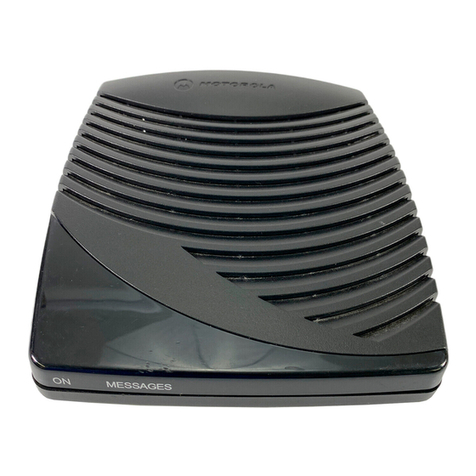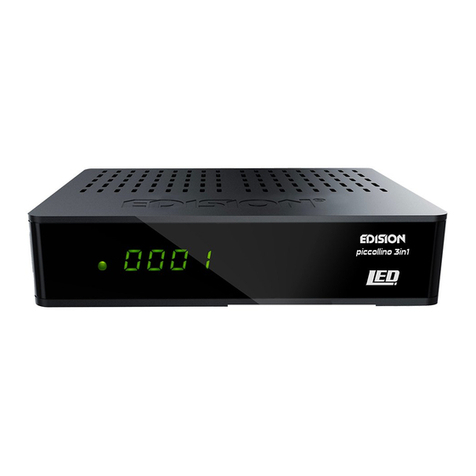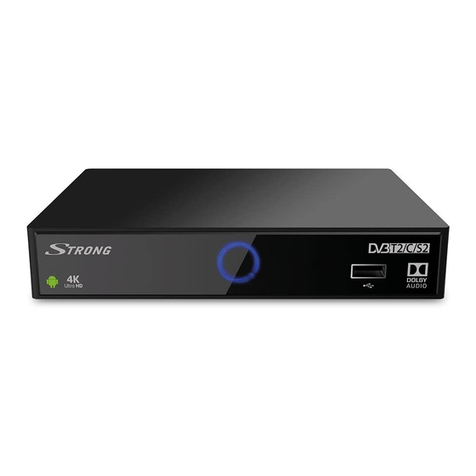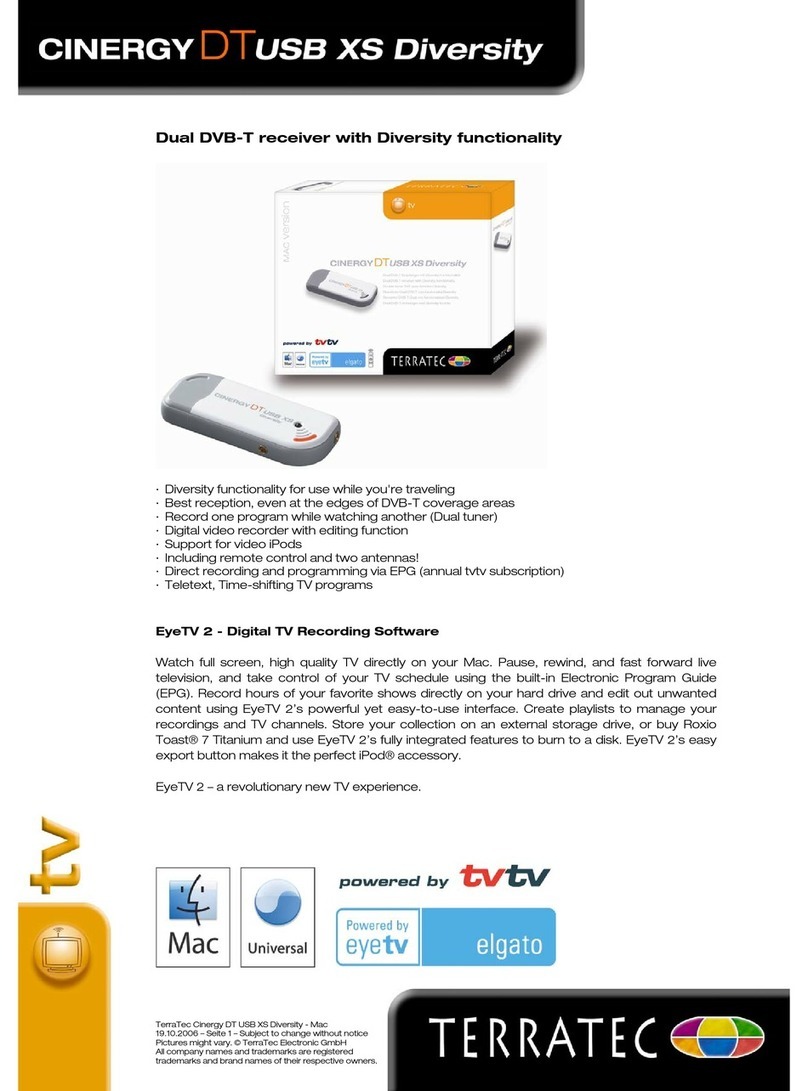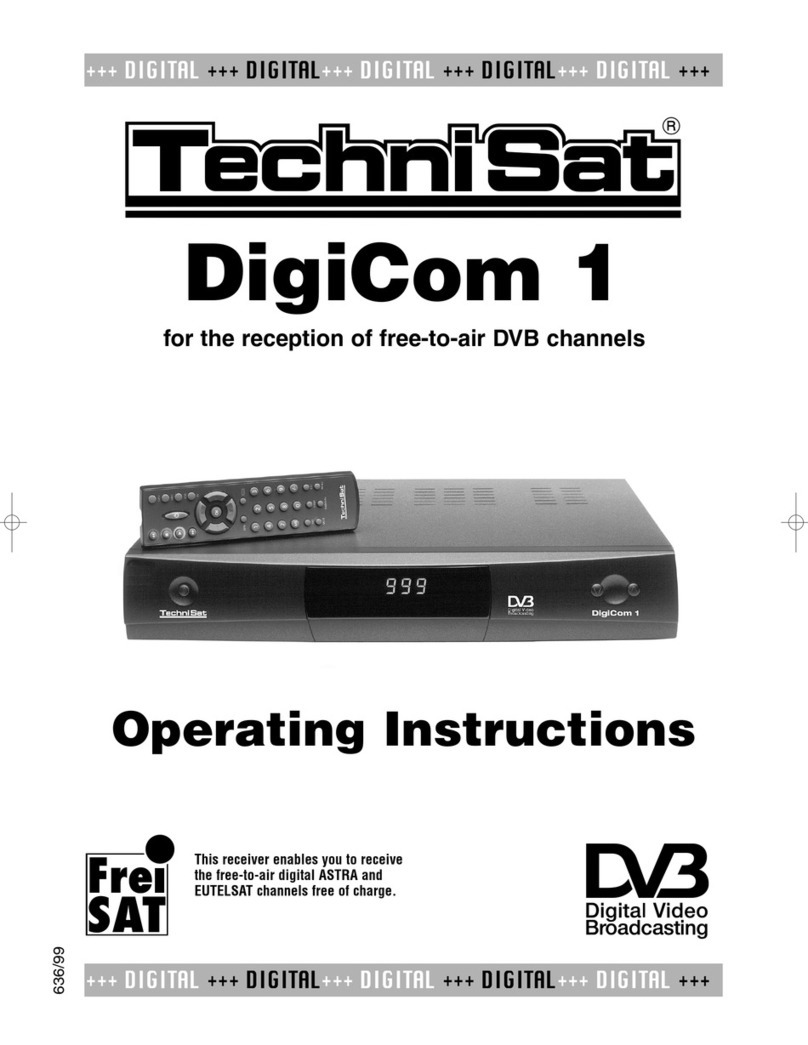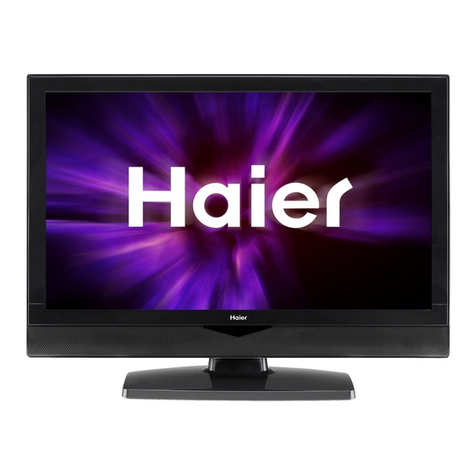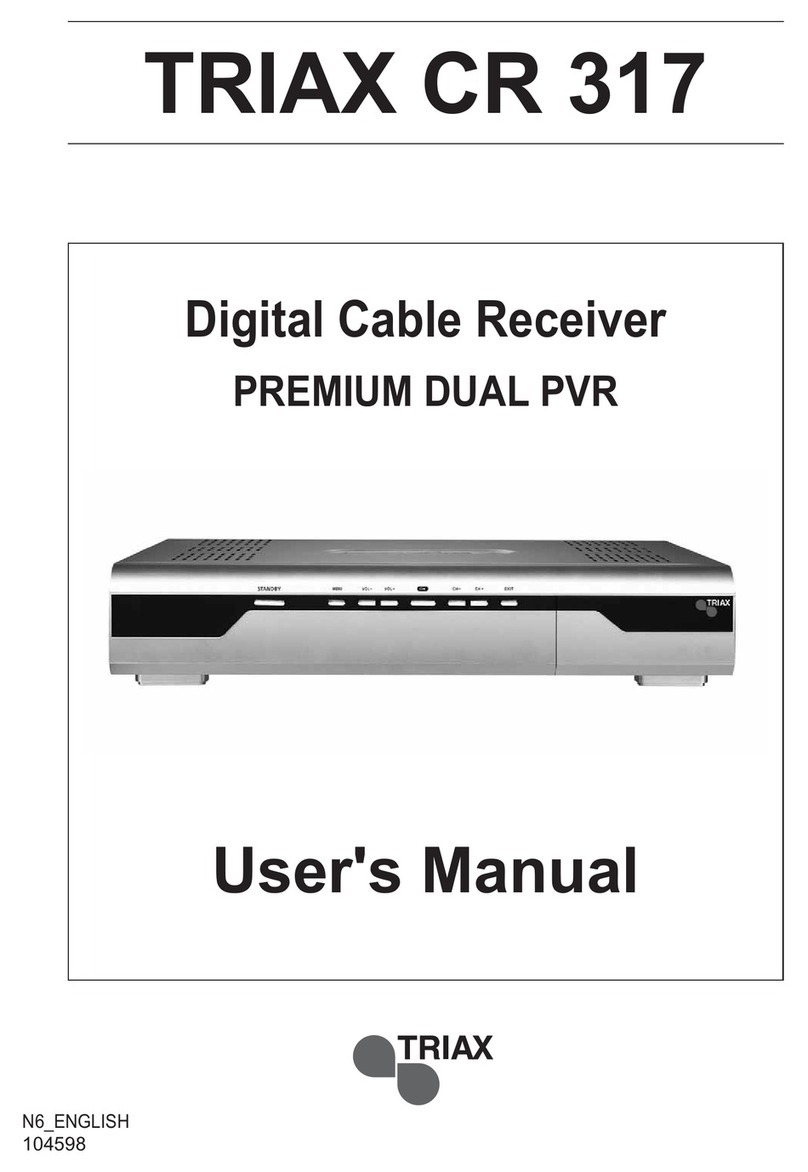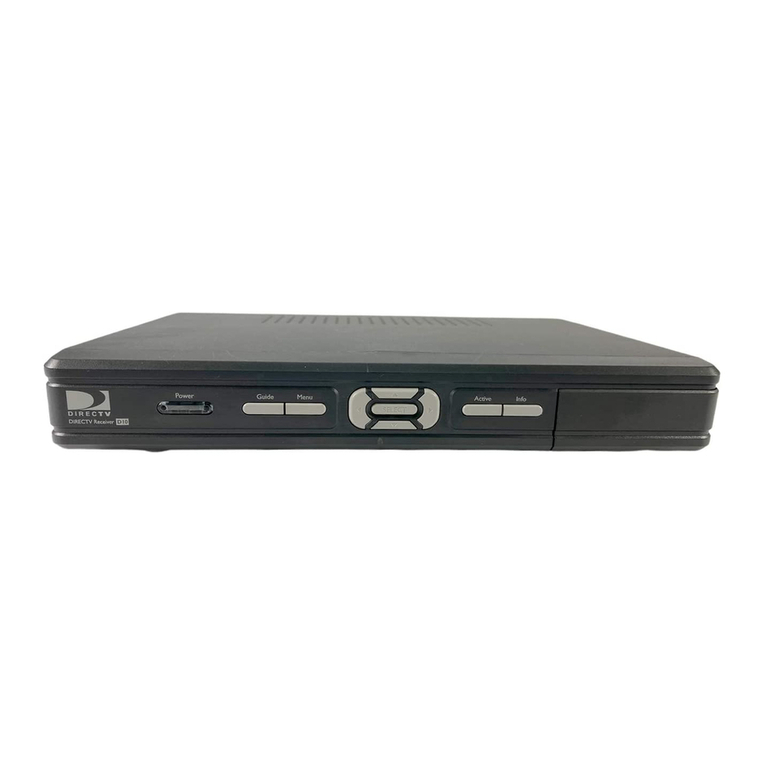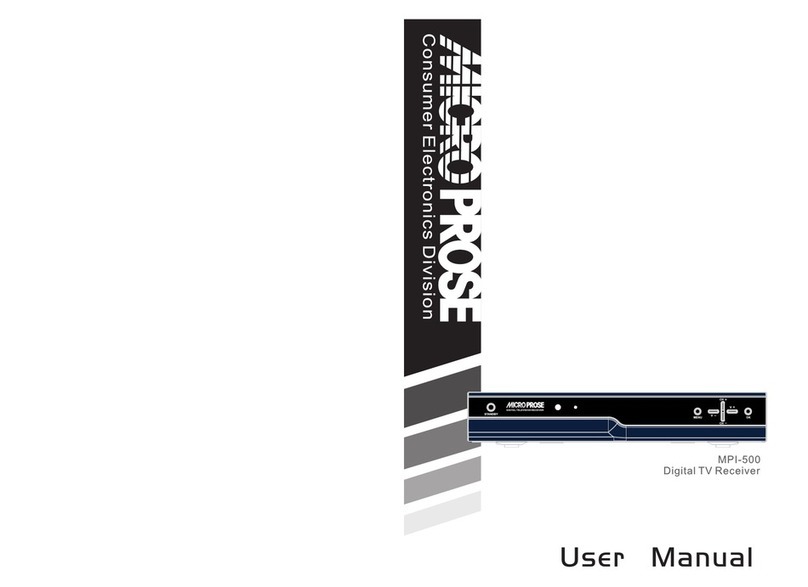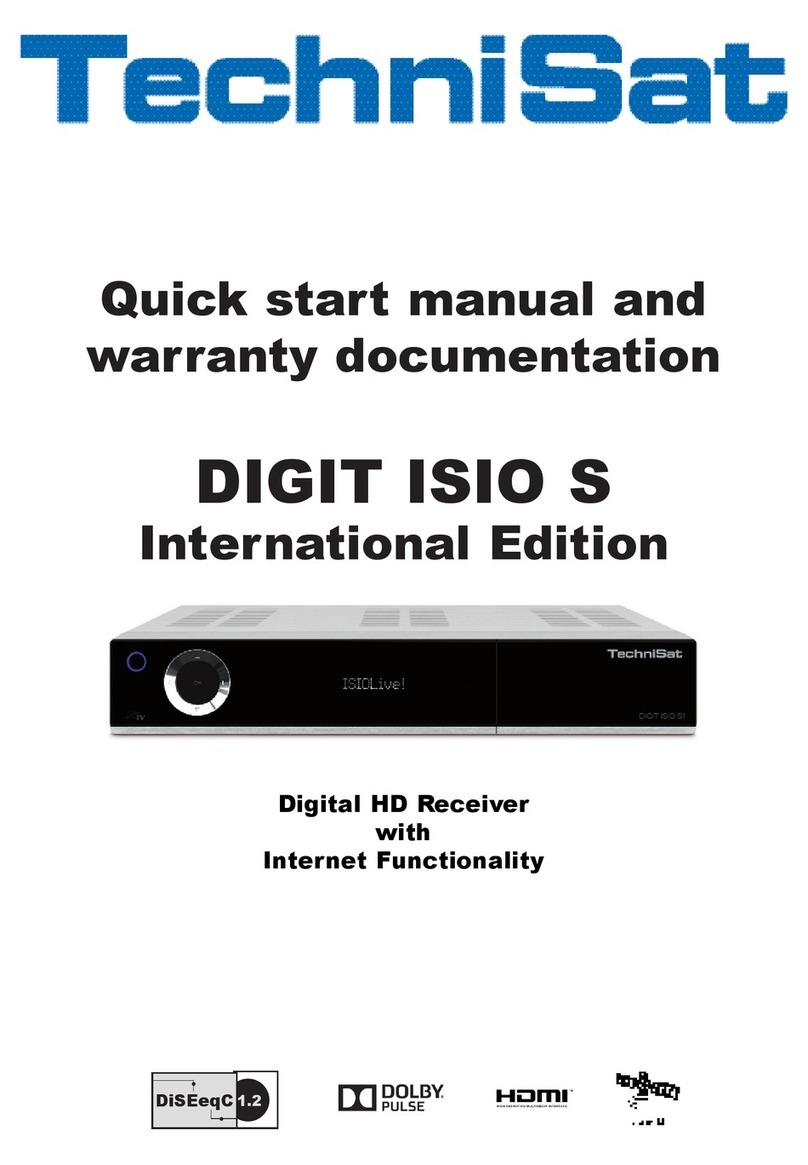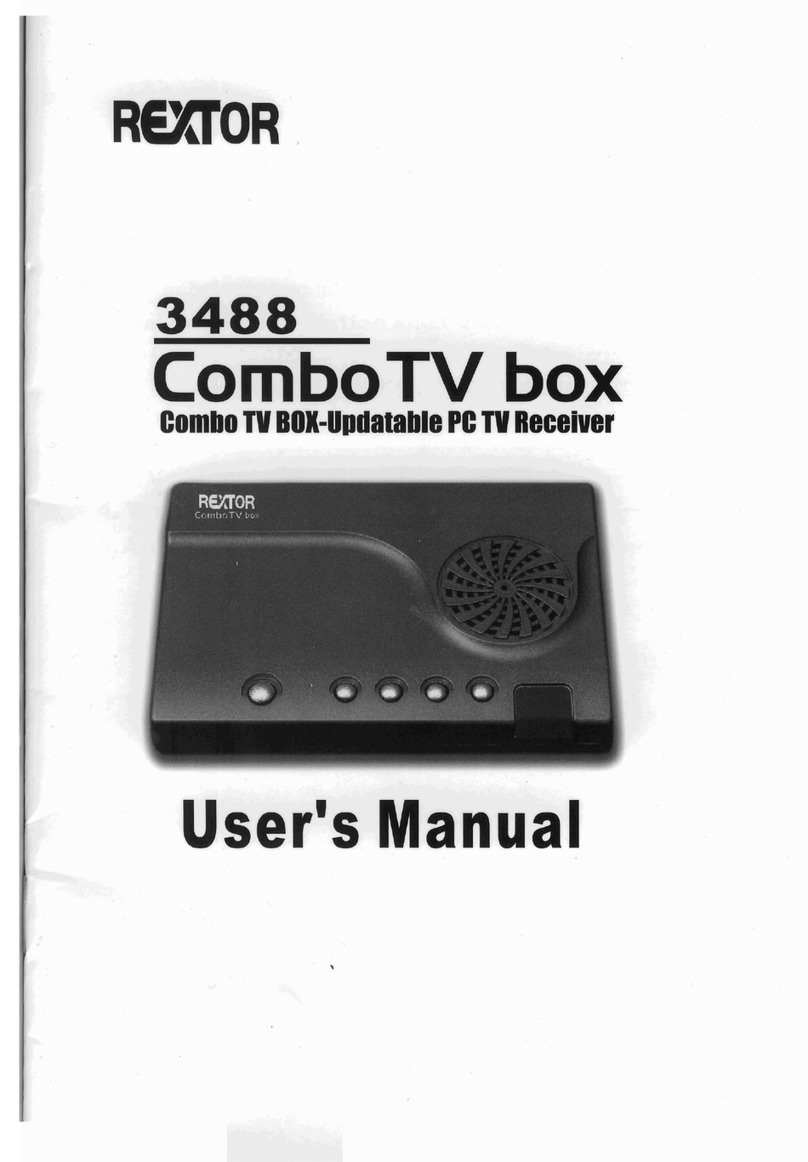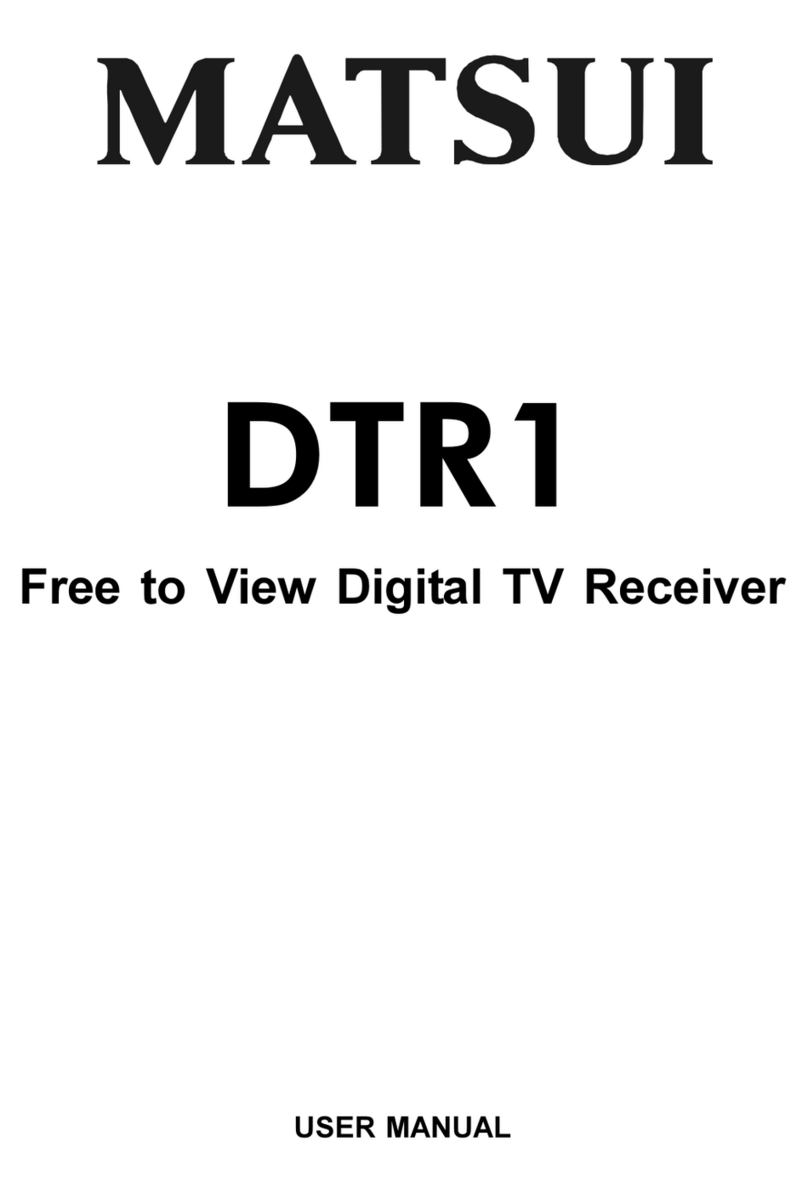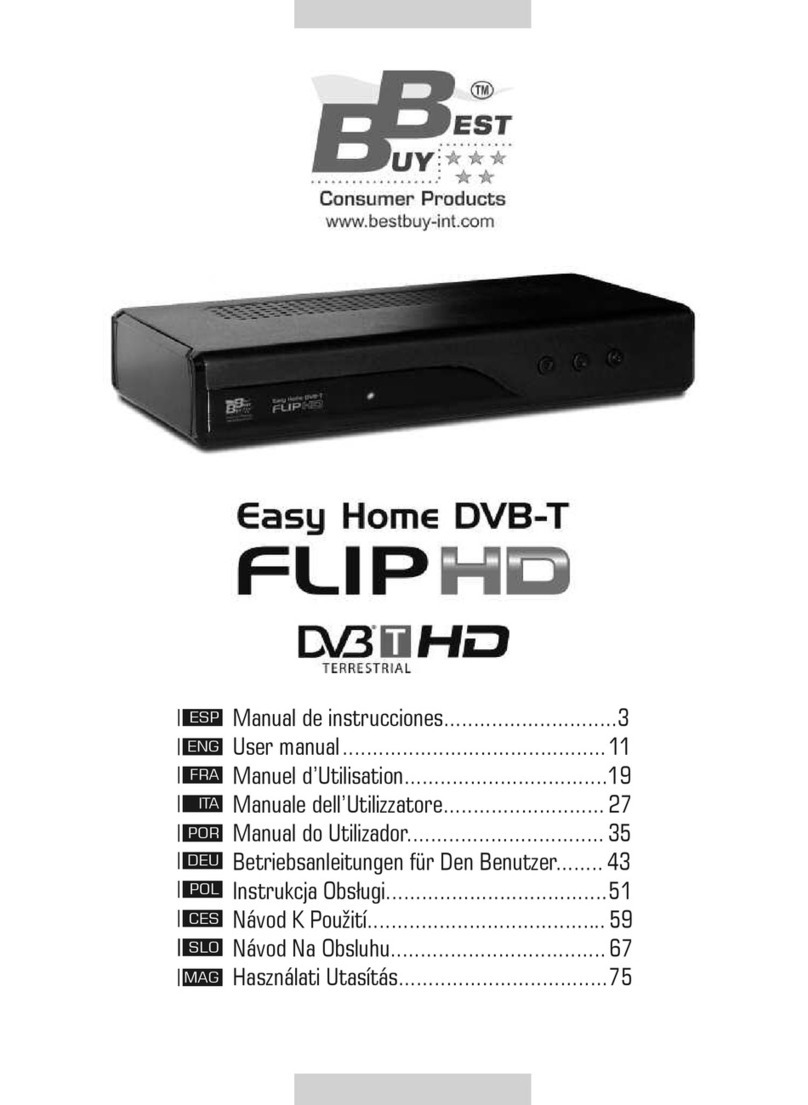Ten-Haaft HD receiver Europe User manual

Version: 03/2013 Language: english
Innovative Mobile Technology
Operating instructions
HDTV
HD receiver
„Europe“

Table of contents
2
1. General information
1.1 Safety information 3
2. Control elements at receiver
2.1 Remote controls 4
2.2 Sat-mouse - operation without remote control 6
3. Operating the receiver
3.1 Receiver menu tree 7
3.2 Channel list / editing 10
3.3 Channel list / scan 12
3.4 Edit settings 13
3.5 Options 14
3.6 Timer 16
4. Device layout and description
4.1 Connections 17
4.2 CI Common Interface module 18
4.3 Software update 19
4.4 Specifications of receiver 20
4.5 Declaration of conformity 21
5. Appendices
5.1 Channel and TV programme list 22
5.2 Appendix: Search satellites 25
5.3 Notes on protection of the environment 27

1.1 Safety information
To avoid the risk of fire or damage to the device, the receiver must never be exposed
to moisture or rain.
Should an item or liquid get into the housing, immediately disconnect the de-
vice from the power supply and have it checked by a qualified professional before
further usage.
Place the receiver in a place with sufficient air circulation and away from
any heat sources. This will prevent heat accumulation inside the receiver and
ensures a longer lifecycle. Do not place any items on the receiver – malfunctions,
damage and even self-ignition may occur if the ventilation openings are blocked.
Should you ever notice an unusual smell or smoke, immediately disconnect the
device from the power supply and have it checked by a qualified professional.
Switch off the receiver before connecting other devices. The power supply line to
the receiver must have a cross-section of 2.5 to 4,0 mm² and must be connected
directly to the vehicle battery. Ensure that the device is not connected to an elect-
ronic charge controller.
Keep a sufficient distance to potential sources of interference such as mobile pho-
nes, electronic heater controllers, igniter components or radio devices when routing
the lines and positioning the components.
It is recommended that you ground your television set in the vehicle to avoid inter-
ference on your television set or satellite receiver. Only connect the freely accessible
ground of your television set to the vehicle chassis.
Only use the wiring harnesses supplied or the extension wiring harnesses available
as accessories to connect the top box. The extension wiring harnesses are available
for the Oyster® Digital system only.
3

2.1 Remote controls
4
P+
OK
P-
-+
TEL: +49(0)7237/4855-0
www.ten-haaft.com
Switches the receiver on and off (Power)
Mutes the sound
Activates sleep mode if pressed for more than 3 seconds
Number buttons for direct channel selection
Changes between TV and radio mode
Selects favourite channels list
Volume control
Channel up/down
Opens display menus
Returns to previously selected programme
Switches teletext mix-mode on and off
Shows current programme information (EPG)
Menu navigation up
Normal mode: Channel up/down
Menu navigation down
Normal mode: Channel up/down
Menu navigation left
Normal mode: Volume control
Menu navigation right
Normal mode: Volume control
Selects or confirms functions
Opens the programme list
Closes on-screen menus / switches teletext off
Blank button
Displays the electronic programme guide (EPG)
Starts the teletext function of the receiver

5
P+
OK
P-
-+
TEL: +49(0)7237/4855-0
www.ten-haaft.com
Selects sound options
Reverse
Forward
Starts playback
Interrupts playback
Starts the timeshift function
Stops playback
Starts the recording of a programme
Moves 5 minutes backward within the recorded programme
Moves 5 minutes forward within the recorded programme
Displays the recordings overview
Displays the timer list
Selects the video resolution of the HDMI output
Blank button
Activates the loop-through for analogue and digital video and
audio signals
Opens the service menu

2.2 Sat-mouse - operation without remote control
The two buttons on the sat-mouse allow you to control the following basic
functions of the receiver when the remote control is not
available:
When in stand-by mode, a brief press on both buttons switches the receiver back
on. When in „power-saving“ stand-by mode, the receiver can only be switched
on using the button combination.
Another control element is the master switch on the front of the receiver.
In position „0“ or „OFF“, the receiver is isolated from the vehicle‘s power supply.
The switch must be in position „I“ or „ON“ for the receiver to operate.
Should the receiver no longer respond to commands, set the master switch to „0“
for approx. 10 seconds and then back to „I“.
Changes to the next channel in the channel list.
Changes to the previous channel in the channel list.
Press both buttons briefly at the same time to toggle between RADIO and TV mode. Holding
both buttons down will cause the receiver to switch off. This corresponds to pressing the red
stand-by button (ON/OFF) on the remote control.
Sat-mouse connector (RJ-45)
Remote control receiver
Left sat-mouse button
Right sat-mouse button
Display
1
4
2
5
3
1
23
4
5
6

7
3.1 Receiver menu tree
Operation with remote control - Press „Menu“
Main menu
Service menu D5000 / standby mode / turning LED display
Channel list
Edit settings
Options
Timer
CI settings
Edit
Search
General settings
File manager
Languages
Reception
Tuner info
Network info
Restore from file
Transponder list
Save to file
Date and time
Web radio
Calendar
Password and protection of minors
System info
OSD
Update software
Audio, Video
PVR / Drives
Network
Restore factory settings
Programme info
Satellite list
Restore factory list

Operation with remote control:
8
Function Setting option
Main menu / Channel list
Edit Sorting channels, editing favourite-channel lists
Search Scan for channels
Save to file Export of channel list
Restore from file Import of channel list
Transponder list Add transponders, Delete transponders
Satellite list Edit basic settings of satellites
Restore factory list Channel lists are reset to default settings
Main menu / Edit settings
General settings CEC control, Remote control, Sleep-timer, Automatic power-down
Date and time Date, time, time zone, daylight-saving time
Languages Menu language, audio language, subtitle language
OSD OSD Display time, Transparency, Radio stillpicture, Channel number timeout
Password and pro-
tection of minors
Setup menu lock, Password, Viewing age, Parental info
Reception Twin LNB, device control, satellite selection, satellite activation, LNB upper
and lower LOF
Audio, Video Format, Scaling method, HDMI signal (resolution), YPbPr, Brightness, Contrast,
Saturation, Digital audio output, HDMI audio output, Lip sync mode
PVR / Drives PVR/drives settings (Internal HDD power down (optional), PVR jump time,
Timer pretime, Timer posttime, Rename selected drive, Format selected drive)
Programme info Programme information for selected channel
PVR / Drives PVR/drives settings (Internal HDD power down, PVR jump time, Timer pretime,
Timer posttime, Rename selected drive, Format selected drive)
Network DHCP On/Off, DNS mode auto/manual
Restore factory
settings
Restore factory settings
3.1 Receiver menu tree

9
Funktion Einstellmöglichkeit
Main menu / Options
File manager Display of drives and files
Web radio Webradio on/off
Calendar Display of calendar of current year
Update software Software update
System info System information
Tuner info Tuner information (current tuner, current satellite, current transponder, signal
level, signal quality)
Programme info Programme information for selected channel
Network info Information about network connected
Main menu
Timer Timer list, Edit timer/Remove item
CI settings Information about CI module and smartcard
3.1 Receiver menu tree

3.2 Edit channel list
Your digital CI receiver provides 10
freely programmable favourite chan-
nels lists.
A favourite channels list is a selection
of channels from the list of all chan-
nels.
When a favourite channels list is acti-
vated, only the channels maintained in
this list are available, all other chan-
nels will be suppressed. The possibility
of creating up to 10 different favourite
channels lists allows different receiver
users to create personal lists without
having to change the complete list of
channels.
Creating favourite channels lists
The favourite channels lists are maintained under MENU -> Channel lists. In this
sub-menu, any channel from the complete channel list can be allocated to any of
the 10 favourite channels list. For operation, observe the help text displayed at the
bottom of the screen. To exit the editing dialogue of the favourite channels list,
press EXIT once or MENU twice. Changes must be confirmed with OK.
Using favourite channels lists
Start the selection menu of the favourite channels list by pressing the „0“ button.
Use P+/P- to select a list and confirm your selection with OK. Now, the channel
list only provides the channels maintained in the selected favourite channels list.
To regain access to the full range of channels, press „0“ again and select <None>.
Please note that you can directly select any channel even if a favourite channels list
is active.
Sorting programs
Use this sub-menu to sort program lists, to insert programs into the list, to rename
programs, to delete programs and to add programs to favourites.
10
SWAP
PLAY
FR/FF
OK
INFO
MENU STOP
EXIT
: Switch active list
: Tune to service
: Index Up / down
: Add to favorites
: Mark service
: Back
: Select Favorite list
: Remove item
: Sort list by name
: Rename service/fav. list
: Lock/unlock channel
: Close menu
Service list editor
TV services Favorites 1
123
0001 Das Erste HD
0002 ZDF HD
0003 SAT.1
0004 RTL Television
0005 ProSieben
0006 RTL2
0007 VOX
0008 WDR HD Köln
0009 SWR BW HD

Creating a favourite list
Press the blue button to select a favourite list (list 1 is preselected). Highlight a pro-
gram in list „TV programs“ and press [OK] to add it to the current favourites list. If
you wish to also add the subsequent program, press [OK] again. Repeat this process
to add all your favourite programs to the list.
Editing program or favourites list
Use the [SWAP] button to select list „TV programs“ or a „Favourites list“ for editing.
Highlight the program to be edited. Now use the buttons [◄◄] and [►►] to
move the program within the list, use the [yellow] button to edit the program name
or the [red] button to delete the program from the list.
Within the text box:
Highlight the text position you wish to edit and change the letters using the num-
ber buttons (e.g. 1 x button [2] = «a», 4 x button [9] = «z»). Use the [blue] button to
change the available character type, the [yellow] button to insert a character, the
[green] button to delete a character, and the [red] button to delete the character
left of the cursor.
This option requires appropriate technical knowledge
In the program menu (press MENU button once), option „Edit channel
list“ provides a sub-menu option „Transponder list“. This sub-menu al-
lows you to view and edit the settings required for the reception of the
individual channels.
Wrong entries at the individual positions may prevent the reception of one or more
channels.
3.2 Edit channel list
11

3.3 Channel list / Scan
First select the satellite to be scan-
ned (e.g. „ASTRA“), then the type of
scan: Auto for a complete scan of the
satellite, or Channel to scan only one
of the satellite‘s transponders.
Then select whether programs of type
Only FTA, Only encrypted services or
All services are scanned.
Then you can select whether TV + Radio, TV only or Radio only programs are scan-
ned. If you wish to scan a specific transponder of a satellite, then you must set the
transponder using the [◄] and [►].
Further information on the scan function:
Make yourself familiar with the scan function and use it regularly. Digital TV is cha-
racterized by frequent additions of new channels.
Also, the data of existing channels is subject to change.
The search function automatically updates the internal channel list if you confirm
the security prompt with „OK“ when leaving the search function, even if you have
not made any manual changes.
12
EXIT
: Close menu
MENU
: Back
Satellite scan menu
Select satellite:
Scan method:
Kind of service:
TV / Radio:
Edit / select transponder:
Signal level
Signal quality
Sart scanning
0%
0%
Astra 19,2°E
Auto
Only FTA
TV + Radio
1: 10729 MHz V

3.4 Main menu / Edit settings
Editing the receiver settings
Editing the receiver settings /
Menu item General settings
Editing the receiver settings /
Menu item General settings
-> Remote control selection
(If competing remote controlsare
used.)
13
Settings
MENU
: Back
General settings
Time and Date
Lamguages
OSD
Password and parental control
Reception
Audio, Video
PVR / Drives
Network
Restore factory settings
Konfiguration: General settings
MENU
: Back
EXIT
: Close menu
CEC control
Automatic power down
Remote control:
Sleep Timer:
On
On
A
Off

3.5 Options
1. Signal strength
Once the antenna is adjusted, you
can view the signal level at any time
via sub-menu „Options / Tuner info“.
The signal level is then indicated as
a vertical bar.
The C/N value will indicate the same
value in dB. The higher the number,
the better the reception quality will
be. In satellite mode, and depending
on the channel, a satisfactory TV
picture should be received with any
value above approx. 8. In DVB-T mode
(optional), a C/N value above approx.
15 will provide interference-free
reception.
Note:
Further to the setting of your reception system and your position within the
satellite‘s footprint, signal level also depends on the currently selected channel.
Please take this into account when checking the aim of your antenna using the si-
gnal level display. It is normal that some channels are received with a strong signal
while others are rather weak.
14
Extras
MENU
: Back
File manager
Web radio
Calendar
Software update
System info
Tuner info
Service info
Netzwerk info

2. System info:
Open sub-menu „Options / System
info“ to view the software version
and serial number of your receiver.
This information is required for service
purposes or software updates.
Example:
zten Haaft Serial: 2800805030
zten Haaft Build: EU/3.00
zPSU-Firmware: 1.00
zMotor Revision: 00404
(automatic systems only)
15
3.5 Options
System info
MENU
: Back
EXIT
: Close menu
Bootloader:
Firmware:
MAC address:
Brand
ten Haaft Serial:
ten Haaft Build:
PSU-Firmware:
Motor-Revision:
2012-04-21 23:47
V1.0.0.0 2013-03-05 08:00
02:00:00:00:06:B3
Oyster HDTV
*4294967295*
EU/3.00 Mar 5 2013 08:59:55
1.000
00404

The timer is used to conveniently record programs on the hard disk at pre-set
times.
The timer function is also available on devices without optional hard disk. This func-
tion is particularly helpful if you want to be sure not to miss a program on a certain
channel. The receiver will then switch over to the channel programed in the timer.
16
3.6 TIMER

4.1 Connections
Master switch OFF/ON Slot for CI modules
Switch contact (max. 7A / 30V DC) headphone output (3.5 mm stereo jack)
USB 2.0 port for PVR functions Slot for SD cards
AD
BE
CF
OFF ON
max.7A
USB
SDHC
CARD
3A 10A
COMMON INTERFACE
EUROPE
A B C D FE
Optional: DVB-T/T2/C input
Analogue video signal output (FBAS for older devices, non-HD-compatible)
Digital audio output (S/PDIF, coaxial)
SAT1, antenna input for connection of first LNB of satellite antenna system
Audio input left
Digital audio output (S/PDIF, coaxial)
USB 2.0 port for external USB drive
YPbPr component output (Cinch) for projectors, LCD or plasma devices (HD-compatible)
Connection for optional infrared receiver
SAT2, antenna input for connection of second LNB (recording function)
Audio output right, for external active speakers, HiFi system, etc.
CTRL Out (Cinch), switched voltage 12V / 300mA
LAN, IP network connection
Digital HDMI input (for loop-through of HDMI signals to the HDMI output)
Antenna control for Oyster antenna
Video signal input for AV Loop Through function (FBAS)
Audio output left, for external active speakers, HiFi system, etc.
Audio input right
AV CTRL (Cinch), switched voltage 6V / 12V
Sat-mouse connection for channel display, direct selection and infrared reception
Digital HDMI output for connection of a TV set
Power supply (brown (negative) = ground, red (positive) = 12 - 24 V; black = terminal 15)
5
10
2
6
11
17
14
20
12
18
15
21
13
19
16
22
3
7
4
9
8
17
EXT IR
ANTENNA
CONTROL
USB2 LAN SAT
MOUSE
12V-24V
DC IN
DVB-T/C
SAT1
CVBS L-Audio-R S/PDIF
CTRL
OUT
AV
CTRL
IN
OUT
IN
IN
OUT
IN
OUT
Y Pb Pr HDMI IN HDMI OUT
IN
OUT
SAT2
1 2
315 16 17 18 19 20 21 2214
4 8 10 126
5 7 9 11 13

At the front of the device there are is one slot for modules decoding encrypted
programs.
To prevent damage, only modules with the „PC Card“ logo must be inserted. Any
other module may damage the receiver beyond repair.
Do not use excessive force to insert the module. Rather pull the module back out
of the slot and try inserting it again. Ensure that you insert the module with the
correct side up.
Smartcards are sometimes printed in a confusing way as they are often designed
to be used with other decoders. Most Common-Interface modules are designed to
accept cards with the golden contacts facing upward. Before inserting a smartcard
into the Common-Interface module, make sure that the usually gold-coloured con-
tacts on the smartcard are clean and free of dust.
If a decoder module has been correctly identified, its name is displayed in the main
menu under „Encryption“. When you select the entry for this module in the list and
press OK, a menu will be displayed that is provided by the decoder module. Please
contact the module manufacturer in case of any questions concerning the module.
Note: Some modules only log in completely and provide a menu system if a
valid smartcard is inserted. The OK and EXIT buttons are used to navigate
within the manufacturer-specific menus. If a menu does not respond to the OK
or EXIT command, the dialog can be cancelled by pressing MENU. The receiver
then interrupts the connection to the module‘s menu system.
18
4.2 Common Interface module
Common interface
MENU
: Back
EXIT
: Close menu
Slot: No module

4.3 Software update
Software and channel lists can be
updated using the USB port via menu
item Options / Software update.
Please refer to: www.ten-haaft.com
19
Software update
MENU
: Back
: Cancel
EXIT
: Close menu
Update from file
Update over Internet
Current software version is: V0.0.0.2 2013-01-23 08:23

4.4 Specifications of receiver
Input frequency range 950…2150 MHz
Input impedance 75 Ω
Input level range -60 … -25 dBm
2 input sockets F-standard, female
LNB control signal 22kHz - 13V/18V
Frequency range VHF (174MHz … 230MHz)
UHF (470MHz … 790MHz)
Video decoder H.264 / AVC, MPEG-2
Video resolution 480i/480p/576i/576p/720p/1080i
Modulation types DVBS, DVBS2 QPSK and 8PSK
Video bit rate up to 18Mbit/s
Symbol rate 1 to 45 Msymb/s in DVB-S (QPSK)
1 to 62 Msymb/s in DVB-S2 (QPSK and 8PSK)
FEC (error correction) DVB-S: Viterbi and Reed-Salomon
DVB-S2: LDPC + BCH dual decoder
Signal outputs Video HDMI, YPbPr, FBAS (Cinch)
Audio decoder MPEG layer 1,2,3, AC-3, Dolby Digital
Signal outputs Audio HDMI, SPDIF (coaxial), analogue stereo
(Cinch)
HDMI, SPDIF, FBAS, analogue
audio
loop-through functionality
2 x USB 2.0
Ethernet 10/100 Base-T MAC
Common Interface CI 1.0 according to EN 50221
SDHC Card 1
External IR 1
Switched voltage output 12V / 300mA
Switched output AV 6V/12V 3mA
Switching relay max. 7A / 30V DC
12 V or 24 V (11 V to 30 V) DC
Battery-buffered or electronically stabilized
Technical changes reserved
20
SAT tuner
DVB-T2/C tuner
Audio
connections -
Inputs
connections -
Outputs
Operating
voltage
Video
Table of contents

